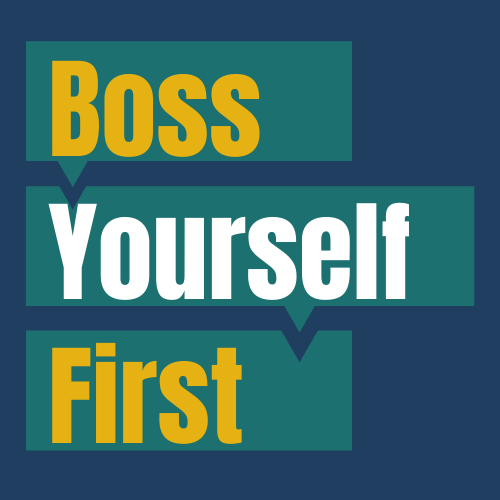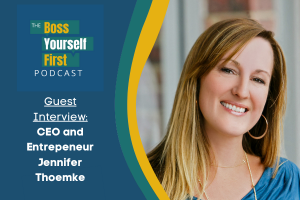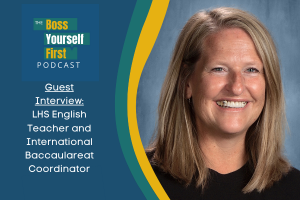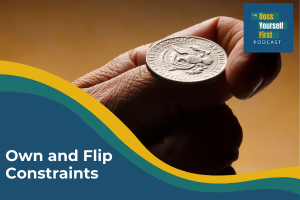Episode Transcript
Boss Yourself First –
BYF Podcast Season 2 Episode 9
Welcome everyone, Thank you for joining me this week, I know I said we’d be starting our constraint hall of fame interviews this week but something has come to my attention that I want to spend this episode addressing and then next week I have an amazing guest interview, we are talking with an amazing woman who is in the trenches of wrestling with constraint as a high school teacher. Shout out to all the teachers who are important and incredible under “normal” circumstances but have been frontline warriors trying to educate our children through the pandemic. I’m so looking forward to sharing that conversation with you.
But I’ve heard from a few of you that there is a different aspect of constraint that bears discussing. And remember so far this season we have been defining constraint as a limitation that we ourselves or circumstances or people outside of ourselves set that inspires creativity and innovation to get to our desired results. But what some of you have told me you would like to explore are constraints or limitations we put on ourselves to protect not necessarily achieve a result. And what happens when those protective constraints are no longer needed. Variations of this came up in a few conversations with listeners, so to me that means we should unpack it.
Some examples of what I’m talking about here. We’ll start off with a really familiar one for most of us. “I’m limiting my physical interaction with others to protect my health during a pandemic.” So a different kind of constraint. Still limitation but to protect. It’s defense instead of offense. Here’s another one, I’m limiting my choices in foods to protect my weight. Or how about this, I’m limiting how and who I’m dating to protect my heart. I’m limiting what jobs I’m applying for to protect my ego. I’m limiting my color choices in my wardrobe to protect my energy around choices. I’m limiting my appointments to protect my time.
So a lot of different scenarios here and I invite you to step out of judgement around all of them. Let these limits be neutral. Because protecting is important. There are things we really want and need to protect. Anything that feels limited in supply but high in demand are valuable resources worthy of protection. like energy, time, attention. It is the work of a self-leader to distribute and invest those resources wisely.
What about the other two we mentioned, health, heart and ego. Again, a skilled self-leader inventories and stewards these aspects of our humanity with wisdom and compassion for themselves and others.
In all of these instances we can think of constraints more like guardrails, that keep us moving forward safely to our desired results. Because I still think you can see the desired result being supported by the constraints above. Results like getting yourself and your family and neighbors through the pandemic unscathed, connecting with others in a fulfilling relationship, losing weight to be healthy and live longer, finding a job that meets your needs and acts as a conduit of meaning in your life, having more energy and still being stylish, managing your time for maximum resilience and impact. So even though you’re building protective constraints, they are supporting your goals.
But how do you know, and here’s the real crux of the questions, how do you know when those limitations are no longer serving you. Or have even become a detriment? Honestly, I think this crosses over bit into the idea of pathway dependence that we discussed at the beginning of this season. When we repeat a way of doing things and in this case a self-imposed constraint, when we repeat it enough, it becomes more of a habit and less of a conscious choice. I believe a self-leader regularly reflects on their habits to make sure they are still the best choice, aligning with current values and goals. And pathway dependence means you’ve had success doing things a certain way to get a result, in this case protecting something, that you lose the vision for a different way of doing things, utilizing your resources differently. So I think this question fits in the pathway dependence conversation but let’s unpack this a bit more.
The question again is how do you now when a constraint is no longer serving you or has become a detriment. When I really focused on this question, I kept seeing an image of the character from Monk. Have you seen that? It’s an older show about a man who already had Obsessive Compulsive tendencies but with the death of his wife he went into high level protection and OCD. And after living in a pandemic, his obsessive use of hand cleaner and wipes just don’t seem that farfetched. And this is an extreme example of constraints. These rules you live by that at some level, protected something you valued but need to be adjusted to make sure that it’s not over protecting and actually holding you back in an important growth area.
And I’ll be honest with you, when I was wrestling with health issues in 2019 and we worked for months getting incorrect diagnosis after incorrect diagnoses and even still we haven’t figured everything out, I searched out and created rules or limitations that I adhered to because I so much wanted to feel better. I’ve shared with you before, the most helpful diagnosis we got was that of paradoxical vocal cord dysfunction and instead of adding more medications, I was allowed to drop most of them and began working with a vocal therapist. One of the first things we did is she had me describe my journey to her, and what showed up in that, was the rules I had been living by and we examined them, kept the ones that supported my healing and discarded the rest. And we added a few new ones to the mix. Part of that healing had been to not talk or whisper for two weeks prior to my therapy, to let my throat heal, but then with her, I began to speak, and even sing among other vocal exercises to work my throat. I remember one morning showing up to therapy and talking softly when my therapist asked my what was wrong. I said that I was so afraid that I had damaged my throat the night before shouting at my dog who was about to knock a hot dish off the stove. She told me something very important, I needed to trust that my throat was strong and getting stronger. I needed to believe it and I needed to live like it. I needed to let go of the constraints that had supported my healing but were no longer needed.
So here are a few steps to discerning if your protective constraint is still supporting you.
Are you growing? And this doesn’t mean growing in every way but do you feel you are continuing on the journey to being your next better version of yourself. I remember a song lyric from a song I liked in high school and I couldn’t really tell you any of the other lyrics but this one stuck, it said if you ever stop growing then you start to die. Asking this question, are you growing will help reveal if you are over-protecting. I’m all for margin and resilience but. Are you underestimating your capacity? Time, energy, family, heart, ego –
So again, you don’t have to be achieving in every area all the time, that’s not how I define growth, but are you continuing to evolve as a human. Taking on challenges, learning new skills, expanding your awareness and impact. If you can’t identify any level of growth, have a look at your self-imposed constraints.
Limitations that once protected you could now be stunting your growth.
You may find it helpful to talk to a good friend or even a coach to help you examine your constraints. Remember these are self-imposed, you get to choose what to keep and what to get rid of.
Another question could be, are you dreaming? I’m not talking about do you dream while you sleep. I’m talking about awake dreaming. Are you playing with ideas about what you would do without any restrictions. Sometimes we are so locked into our constraints that we forget that at least many of them self-imposed. We forget how to look beyond them and think bigger. If you answer that you’re not dreaming, reconnect with old dreams and then ask yourself what experiences would feed your soul? Challenge yourself to make a bucket list. Once that is done, ask what is stopping you from going for something on your list. See if any of those obstacles are self-imposed constraints that no longer serve you.
Once you’ve exposed the constraints that no longer support your pursuit of living according to your values and goals, take steps to let go of them.
The most important place to start in changing an old constraint is your mind. Create a thought that supports the change and repeat it as needed.
For me with my throat, anytime I begin to feel anxious about straining my voice or it’s unreliability, I remind myself that “my throat is stronger than it was and getting stronger every day.”
Yes I still have some self-care constraints that continue on and I show up to do my throat exercises every day but I no longer stress over shouting for my favorite team or singing a familiar tune.
So are you growing, are you dreaming, are self-imposed constraints responsible for a lack in either of those areas. What thought do you need to lift a constraint that has outlived its purpose.
I hope this discussion and these steps give you food for thought and support for your questions around a different aspect of constraint.




